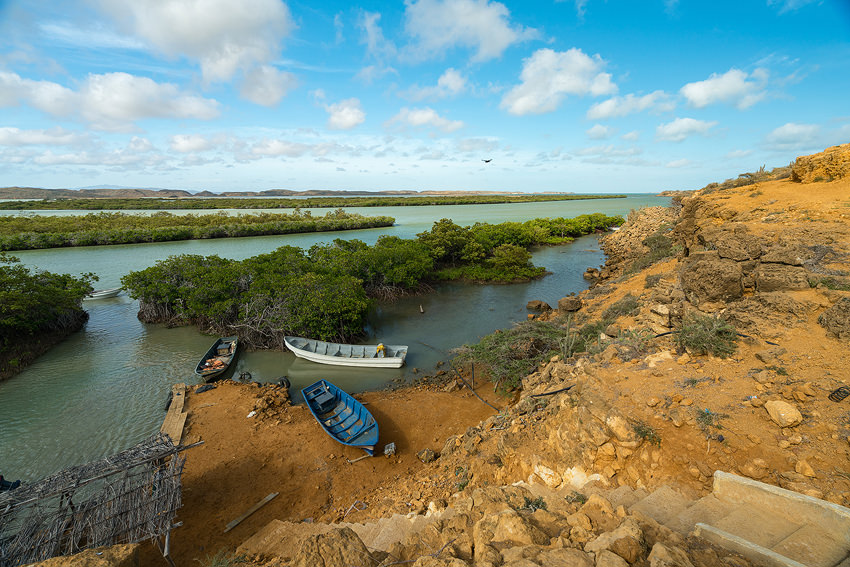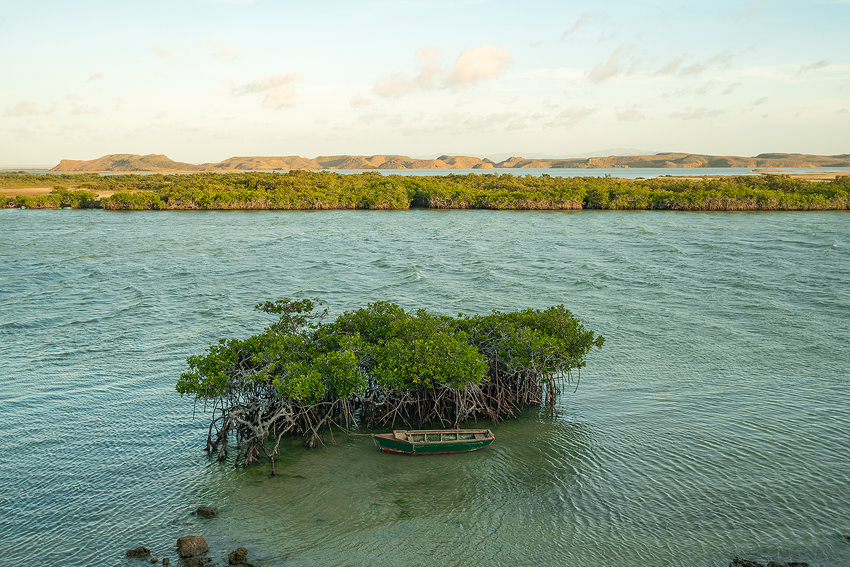
Punta Gallinas – South America’s Most Northern Adventure Point
We were just outside of Cabo de la Vela; a small fishing village in Colombia’s northern desert region known as la Guajira. Our goal was to make it to the most northern point of South America; Punta Gallinas; and the journey was not off to a great start.
The back left tire of our Toyota Landcruiser had blown, and there was no jack. Luckily just as our driver was starting to show the early signs of a tantrum, another truck rolled up and let us borrow theirs.

Off To A Great Start

Ready For The Rough And Tumble Journey
Getting To Punta Gallinas
So if you are wondering how I magically transported myself to the middle of the desert at six in the morning; don’t worry there is a straightforward and cost friendly answer.
In a previous post about Cabo de la Vela – the jewel of la Guajira, I give a full breakdown on how to get to Cabo de la Vela and where to stay. From Cabo, you can hire another 4×4 to Punta Gallinas. Also as I mentioned in the previous post; anything more than 150,000 COP for a tour around Cabo and transport to and from Punta Gallinas is a rip-off.
Travel Tip: The 4×4’s going to Punta Gallinas, leave at half past five in the morning from Cabo de la Vela, so it is not possible to go from Riohacha to Punta Gallinas in one day. You will have to spend the night in Cabo.

At Land’s End
After three hours of whipping back and forth full speed through the desert, we finally arrived at land’s end, the point at which 4×4’s would no longer do the trick. We grabbed our gear, waited at the end of the concrete dock, and loaded into an over crowded lancha (speed boat).
Warning: The operators of the lanchas and the drivers are in cahoots and will try to tell you that the lancha is an extra fee on top of the one you paid for the vehicle. DO NOT pay them. It is included in the price and saying no a few times will sort all of that out.

Have We Finally Arrived?

Welcome To Hospedaje Alexandria

Desolate Campgrounds
A hammock will cost you 20,000 COP or $6.75 USD, and a Chinchorro (a large hammock) will set you back 25,000 COP or $8.40 USD. I highly recommend the Chinchorro; it allows you to lay diagonal and almost completely flat. The extra 5,000 COP is worth a good nights sleep. There are four dinner options and a small selection of á la carte items as well.
- Vegetarian – 12,000 COP or $4 USD.
- Chicken or fish – 15,000 COP or $5 USD.
- Lobster – 40,000 COP or $13.50 USD
The meals are very good considering you’re in the middle of nowhere. They also have a nice selection of beers and soft drinks ranging from $1 – 2 USD.

Vibrant Desert Wall Art
After orientation and putting in your lunch order you will be shown to your sleeping area.
Warning!: There are no lockers at the hostel, so your gear will just be sitting out in the open. We had someone steal some money, and a few other small items while we weren’t watching. I would bring everything worth value with you wherever you go. If your stuff does get stolen, they will not do a single thing about it. They just claim that there are different rules in the desert.
With your valuables and a bottle of water in hand, you should now be ready to have yourself some fun in the dry, desolate desert. You will load up in the back of one of the hostel jeeps and head off to your first adventure destination.

Faro Punta Gallinas
Faro Punta Gallinas

South America’s Northern Point

Leaving Our Mark

Mirador Casares
Mirador Casares

Beauty In Nothingness
We got the luck of seeing a pond instead of a vast body of water. The place was still fantastic though. Most of the time you judge beauty based on the content of a landscape, but every once and awhile the beauty of a place lies in its lack of content entirely.
Once again we hopped in the back of the Landcruiser and headed off down the dusty desert road. Our next destination was a set of sand dunes further down the coast that we had been waiting all morning to see.

The Taroa Sand Dunes
Taroa Sand Dunes
The Taroa sand dunes (Las Dunas del Taroa) are the star attraction of Colombia’s northern desert coast. These massive mountains of sand rise high above the desolate landscape and roll right into the turquoise waters of the Caribbean ocean below.
Strong northern winds smash the coast, picking up sand and throwing it at high speeds straight into your face. It’s like walking inside of a sand blaster. The only relief from the burning sand is the cool salty waters at the base of the dunes.

Waves Of Sand And Water
You will have an hour and a half to explore the dunes. I recommend running as fast as you can from the top all the way down to the ocean and try not to topple over. It is a huge adrenaline rush if that is your sort of thing.
I also recommend walking past the dunes away from the drop off point. It is like being thrown into the heart of a middle eastern desert. Except you’re in Colombia; a very bizarre feeling indeed.

Am I In The Middle East?
After the allotted time has passed, the hostel 4×4’s will arrive, and everyone will cram into the back; much more salty and smelly than before. The ride back to the hostel is a little more annoying this time around, but hopefully the high of what you just experienced will get you through it.
Lunch will be waiting for you upon returning to the campgrounds. Again you have the four meal choices; vegetarian, chicken, fish, or lobster. The hostel also offers two additional tours at minimal costs. The first being a trip out to a small bay to see flamingos. It should cost 5,000 COP or $1.50 USD. The second tour is a short ride to Playa Aguja to release some baby sea turtles which will cost you a whopping 8,000 COP or $2.40 USD. If you’ve already done these things before and just want to venture out on your own that is entirely doable as well.
A nice walk to Punta Aguja and Playa Aguja is an excellent way to break away from the group and enjoy a fantastic sunset. Who knows, you might even make a friend or two.

Walking The Dog At Sunset
I’m sure that if you have been anywhere in Latin America, then you know that it is almost impossible to walk somewhere remote without picking up a few stragglers. It’s more good company than annoying.
The sun at around half past five is hanging in just the right spot. Soft, warm winds blow from the North as you pass fishing boats tied up for the night. The sky is filled with pastel painted clouds, and the surrounding hills are on bright display.

Tie It Up For The Night Jorge
The sun sets around sixish for most of the year which is timed perfectly for dinner. The plates start flying at seven and the final bills are paid shortly after. Don’t worry; the woman who runs the joint is top notch and keeps excellent track of what you add to your tab. No funny business when it comes to la cuenta (the bill).
After some beers and a game of cards, we hit the hay, or hammock however you want to look at it. Again, I can’t stress it enough. Make sure you have your valuables with you at all times. I hate that this is even a problem but losing a passport and all your money in the middle of the desert is probably not going to make the rest of your trip very enjoyable.

One Last Sunrise In Paradise
The next morning you will be faced with a difficult decision. Do you load up on the boat and head home, or do you sleep in and stay an extra day in Punta Gallinas?
Well, that all depends on if you told your driver that you wanted to stay an extra day. If not, things can get very complicated. It also depends if you feel like the people that run Hospedaje Alexandria deserve more of your hard earned money after doing nothing about the thefts the night before.
If you’re like most, you will pack your bags and wait for the first boat to arrive at eight. I decided to go off the path a bit and sit along the shore to watch one last sunrise in paradise and….
It was so worth it.
What To Bring To Punta Gallinas
Punta Gallinas, like Cabo de la Vela, is remote and very costly when it comes to the necessities. So with that in mind, you will naturally want to plan out how much cash to bring as well as any supplies you might need.
I recommend that you bring at least 300,000 COP or $90 USD. That should cover the tour, accommodations, and sustenance. If you plan on doing some kite surfing in Cabo de la Vela, then I would plan the extra cash accordingly.
★ For a list of what gear to bring on a journey like this check out my complete backpacking checklist with links to all the gear that keeps me on the road and ready for any adventure.
So what do you think?
Does a vast empty desert get you excited?
Have you already been to Punta Gallinas? If so; what was your favorite part?


Such a great time in so few hours! Looks like a beautiful place.
It was my favorite part of Colombia, hands down.